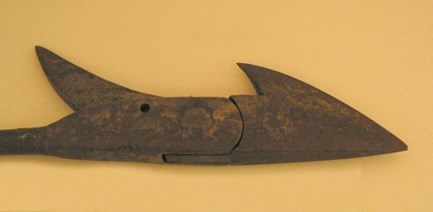
Lewis Temple was born in Richmond Virginia, but it is unclear whether he was born free or born a slave. Upon arriving in New Bedford in 1829, Temple took up work as a blacksmith and married Mary Clark of Maryland on June 20, 1829. In 1834, he was elected vice president of the New Bedford Union Society, the village’s first anti-slavery society and one of the black auxiliaries to the Massachusetts Anti-Slavery Society founded a year earlier. While working in his shop on Walnut Street in 1848, Temple invented an improved harpooning instrument. Now called the Temple toggle iron, his creation had a pivoting head that would secure the harpoon into the whale’s flesh. Earlier harpoons would often work loose in the fury of the fight. The tool revolutionized 19th century whaling. 
In the fall of 1853, Temple fell while crossing a plank over an open sewer trench. He sustained serious injuries. In March 1854, the city approved a $2,000 payment to Temple, but he died six weeks later. His personal estate was valued at $2,459.75. That included the money owned to his widow by the city, which was finally paid with interest in February 1857. A monument honoring Temple stands in front of the New Bedford Free Public Library on Pleasant Street in New Bedford. No likeness of Temple exists, so the monument is based on a photograph of his son, Lewis Temple, Jr. |
Last updated: August 2, 2018
